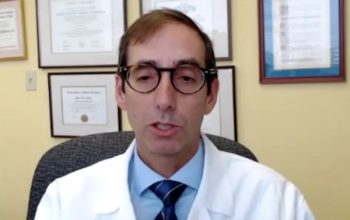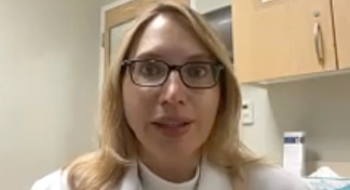
"The fact that it was a simple blood test, it was absolutely objective, and it was…non-invasive…made it very attractive," says William J. Catalona, MD.

"The fact that it was a simple blood test, it was absolutely objective, and it was…non-invasive…made it very attractive," says William J. Catalona, MD.

"This field has exploded!" says Mohit Khera, MD, MBA, MPH.

"The newest frontier of therapy for stress incontinence is regenerative medicine and stem cell–based therapies," says Melissa R. Kaufman, MD, PhD, FACS.

"These are fairly new technologies, but they've already made a dent into patient care," says Anthony Atala, MD.

"Introducing something that with a prefashioned sling, [something] we're able to utilize with the patient in an ideal situation just under some deep sedation and local, really opened this up the ability for many more women to be treated and allowed many more physicians to be trained and to utilize this technology," says Howard B. Goldman, MD, FACS.

"A major innovation impacting urology and oncology is the therapeutic advances based on genetic information," says Veda N. Giri, MD.

"There have been few therapies that have so galvanized management of a urologic condition as what we've witnessed over the past decade regarding the use of onabotulinumtoxinA (Botox) for bladder dysfunction," says Melissa R. Kaufman, MD, PhD, FACS.

"Intermittent catheterization is an important concept in urology, and it has a long history," says John Stoffel, MD.

"Viagra has revolutionized the field of sexual medicine and impacted how we go about therapies," says Arthur L. Burnett, MD, MBA, FACS.

"Active surveillance is an innovation because it's truly a departure from the idea that all prostate cancers or cancer, in general, needs to be treated," says Kara L. Watts, MD.

"It is clearly the standard and it's the treatment of choice. When you have that, and it's very good, it's evidenced by the fact that none of the agents are compared against BCG because it sets such a high standard of effectiveness," says Sam S. Chang, MD, MBA.

"The seminal innovation was the idea that you could create a focused shock wave that could be delivered into the body in a non-invasive way that had sufficient energy to break up a stone but not damage other structures," says James E. Lingeman, MD.

"We as urologists are board certified to take care of all genders. We are really good sexual medicine doctors, and we need to apply what we know about sexual medicine, not just for our male patients, but for all of our patients," says Rachel S. Rubin, MD

"Cryotherapy was the first energy source that we were able to ablate tissues with in either the kidney or prostate and understand what that ablation would do," says J. Stephen Jones, MD, FACS.

"Peyronie's disease has really seen a wide range of intralesional options through the years," says Denise Asafu-Adjei, MD, MPH.

"I would say our greatest advance of the past 30 years is our clinical trials infrastructure, because we can now use our therapies with intelligence," says Anthony Zietman, MD.

"β3 agonists really provided a new drug class of medications for patients with overactive bladder. Previously, there were no alternatives," says Ekene Enemchukwu, MD, MPH.

"Micro TESE is associated with higher sperm retrieval rates compared with conventional testicular sperm extraction, so this approach has really become the gold standard for sperm extraction in patients with non-obstructive azoospermia," says Denise Asafu-Adjei, MD, MPH.

"Anatomic radical prostatectomy really transformed radical prostatectomy from a very morbid operation with high risk, performed rarely, to one that became a commonly utilized treatment for prostate cancer," says Christopher L. Amling, MD, FACS.

“In using an immune therapy approach, and using your own cells, it's very innovative in the mechanism that it works,” says Kelvin A. Moses, MD, PhD.

"In trying to localize and focalize the treatment on just the lesion of prostate cancer, HIFU was incredibly powerful in the sense that it really allowed you to do that with great precision," said Jennifer Linehan, MD.

In this video, Adam S. Kibel, MD, discusses the development of transrectal ultrasound-guided prostate biopsy and how prostate biopsy has continued to evolve over the years.

"It's not perfect; you have to sort of retrain it, and there are some downsides to it. But it's the closest that we can get to, essentially, an artificial bladder," says Eila C. Skinner, MD.

“What made [multichannel urodynamics] so important is you're able to diagnose things much better; you're able to have a much better understanding of what's actually going on,” says Howard B. Goldman, MD, FACS.

“When you're talking about ‘impact,’ I don't think it gets any bigger than treating male infertility, because you're surgically treating the man, of course, but you're really treating the couple as a whole, and you're helping potentially create a new life,” says Justin Dubin, MD.

“Our ability to develop innovative technologies and approaches continues to evolve. We have newer molecular profiling techniques that are being applied to urine at the moment,” says Simpa Salami, MD, MPH.

“There are numerous trials that say that if you use blue light cystoscopy, in about 25% of patients, it will help you pick up a tumor you otherwise would have missed with traditional white light cystoscopy,” says Sanjay Patel, MD.

“LHRH therapies are not going away. They are the standard of care,” says E. David Crawford, MD.

"I would argue most people perform complicated vesicovaginal fistula repairs that can't be reached vaginally using a robotic abdominal approach," says Nitya E. Abraham, MD.

"This device has been really well studied, and we have lots of data on it," says Andrew C. Peterson, MD, MPH.